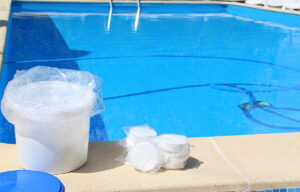
How exactly do you shock a swimming pool? Our helpful guide will teach you the proper method for a traditional chlorine pool.
Maintaining a clean and healthy swimming pool is essential for ensuring everyone’s safety and enjoyment. One crucial maintenance task is “shocking” the pool, which involves adding a high dose of chlorine or other chemicals to kill bacteria, algae, and other contaminants. Shocking a pool can be straightforward if you follow these steps carefully. This guide will walk you through the entire process, ensuring your pool remains crystal clear and safe for swimming.
What is Pool Shocking?
Shocking a pool means adding a large amount of chlorine or other chemical sanitizers to raise the chlorine level quickly. This process helps to:
- Kill bacteria and algae
- Break down organic contaminants such as sweat, oils, and urine
- Clear up cloudy water
- Remove chlorine odors
When to Shock Your Pool
- Regular Maintenance: Generally, shocking your pool every 1-2 weeks helps maintain clear water.
- After Heavy Use: If you’ve had a pool party or a large number of swimmers, it’s a good idea to shock your pool.
- After Heavy Rain: Rain can introduce contaminants and dilute the chlorine levels in your pool.
- If the Water is Cloudy or Green: This indicates the presence of bacteria or algae.
- After a High-Temperature Period: Hot weather can reduce chlorine levels faster.
Materials Needed
- Pool shock (chlorine-based or non-chlorine-based)
- Protective gear (gloves and goggles)
- Pool brush
- Pool test kit or test strips
- Pool skimmer
- Bucket (for pre-dissolving shock)
Step-by-Step Guide
Test the Water
Before you begin, test your pool water to determine the current chlorine level and pH. The ideal pH level should be between 7.2 and 7.6. Adjust the pH if necessary, as a balanced pH ensures the shock treatment will be more effective.
Calculate the Amount of Shock Needed
Read the instructions on the pool shock package. Typically, you need 1 pound of shock for every 10,000 gallons of water, but this can vary depending on the product and the condition of your pool.
Choose the Right Time
Shocking is best done in the evening or at night. Sunlight can reduce the effectiveness of the chlorine, so allowing the shock to work overnight ensures maximum efficiency.
Prepare the Pool
Remove any debris from the pool using the pool skimmer.
Brush the walls and floor of the pool to remove any algae or dirt, helping the shock to work more effectively.
Pre-dissolve the Shock (if required)
Some shock products need to be pre-dissolved in a bucket of water to prevent bleaching of the pool liner. Fill a bucket with pool water and add the shock, stirring until it is fully dissolved.
Add the Shock to the Pool
Slowly pour the shock around the edges of the pool. If you have pre-dissolved it, ensure an even distribution.
Avoid pouring all the shock in one spot, as this can cause staining or damage to the pool liner.
Run the Pump
Turn on the pool pump and let it run for at least 8 hours, preferably overnight. This ensures the shock is evenly distributed throughout the pool.
Test the Water Again
The next day, test the chlorine level again. It should have returned to a safe range (1-3 ppm for chlorine). If the chlorine level is still too high, wait a few more hours before swimming.
Monitor and Maintain
Regularly check and maintain your pool’s chemical levels. Consistent monitoring helps prevent issues that require heavy shocking and keeps your pool water safe and clear.
Tips and Precautions
- Always wear protective gear when handling pool chemicals.
- Follow the manufacturer’s instructions carefully.
- Store pool chemicals in a cool, dry place, away from children and pets.
- Never mix different types of pool chemicals, as this can cause dangerous reactions.
Do You Have More Questions About Spas? Ask Sunrise Premiere Pool Builders LLC
If you still have questions about how to build a brand new swimming pool, Sunrise Premiere Pool Builders LLC is here to help you. At Sunrise Pools, we can build and install your pool, spa, or hot tub and provide you with pool chemicals, services, and more. If you have questions, feel free to give us a call at 410-349-3852. To see more from us and for tips and tricks, be sure to follow us on Facebook, Twitter, Pinterest, and LinkedIn.
